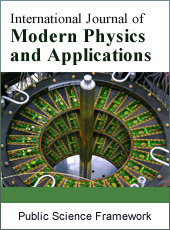International Journal of Modern Physics and Applications
Articles Information
International Journal of Modern Physics and Applications, Vol.1, No.4, Sep. 2015, Pub. Date: Jul. 20, 2015
Origin of the Cusp Phenomenon of the Coercivity Curve of the Stoner-Wohlfarth Magnet Under Stress
Pages: 139-144 Views: 3707 Downloads: 10293
[01]
Zi Zheng Guo, Department of Applied Physics, College of Electronic Engineering, South China Agricultural University, Guangzhou, China.
In this paper, we study a Stoner-Wohlfarth (SW) magnet under stress and explain the origin of the cusp phenomenon of its coercivity curve. With the help of the method of vector composition, the uniaxial magneto-crystalline anisotropy field and stress anisotropy field of the magnet are combined into an equivalent uniaxial anisotropy field (the resultant of the two fields), therefore, the magnet can be resolved using the SW model to analyze its stress-dependent nature. Based on that, the cusp phenomenon of the coercivity curve as the function of stress intensity is reproduced successfully. This phenomenon was reported as early as 1999, but has not been explained satisfactory. It is shown that the cusp phenomenon is the result of the shift of the equivalent easy axis, or the competing between the stress anisotropy and the uniaxial anisotropy. The existence of double-cusp phenomenon in the systems with exchange bias is also predicted.
The Stoner-Wohlfarth Model, Coercive Force, Stress, Cusp Phenomenon
[01]
R. Prasad, M. P. Singh, W. Prellier, P. K. Siwach, R. Rawat, A. Kaur and H. K. Singh, Phys. Stat. Sol. (B), 246,1662(2009).
[02]
Zhibin Wang, Jinghua Liu, Chengbao Jiang, and Huibin Xua, J. Appl. Phys.,108,063908 (2010).
[03]
D. Miyagi, K. Miki, M. Nakano, and N. Takahashi, IEEE Trans. Magn., 46,318(2010).
[04]
Cheng-Yen Liang, Scott M Keller, Abdon E Sepulveda, Alexandre Bur, Wei-Yang Sun, Kyle Wetzlar and Gregory P Carman,Nanotechnology, 25, 435701(2014).
[05]
M. Jeun, L. Lin, H. W. Joo, S. Bae, J. Heo, and K. A. Lee, Appl. Phys. Lett., 94,152512(2009).
[06]
A. Ktena, J. Phys.: Conf. Ser., 585, 012001(2015).
[07]
M. J. Sablik and D. C. Jiles, J. Phys. D: Appl. Phys., 32,1971(1999).
[08]
B. Zhu, C.C.H.Lo, S.J.Lee and D.C. Jiles, J. Appl.Phys., 89,7009(2001).
[09]
V.Permiakov , L.Duprea , A.Pulnikova and J. Melkebeek ,J. Magn.Magn. Mater.,272–276 ,e553(2004).
[10]
K. Yamamoto and S. Yanase ,PRZEGLĄD ELEKTROTECHNICZNY ,87,97(2011).
[11]
J. Escrig, M. Daub, P. Landeros , K. Nielsch and D. Altbir, Nanotechnology, 18,445706(2007).
[12]
A.Ghaddar, F.Gloaguen and J.Gieraltowski, J. Phys. :Conf. Ser., 200,072032(2010).
[13]
K.Yamamoto and Y. Yamashiro, J. Appl. Phys., 93,6683(2003).
[14]
D. Braun, J. Magn. Magn. Mater, 261,295(2003).
[15]
B. Peng, W.L.Zhang, W.X.Zhang, H.C. Jiang and S.Q.Yang, Physica B, 382,135(2006).
[16]
Z. Z. Guo, Solid State Commun., 151,116(2011).
[17]
Y. Ma and A. Du ,Phys. Stat. Sol. (B), 245,740(2008).
[18]
Y. Hu, Y. Liu and A. Du, Phys. Stat. Sol. (B) ,247 ,972(2010).
[19]
H. P. Yang and Y. H. Bai, Physica B, 433, 12–20(2014).
[20]
H. P. Yang and Y. H. Bai , Chin. Phys. B, 23, 067503(2014).

ISSN Print: 2381-6945
ISSN Online: 2381-6953
Current Issue:
Vol. 7, Issue 1, March Submit a Manuscript Join Editorial Board Join Reviewer Team
ISSN Online: 2381-6953
Current Issue:
Vol. 7, Issue 1, March Submit a Manuscript Join Editorial Board Join Reviewer Team
| About This Journal |
| All Issues |
| Open Access |
| Indexing |
| Payment Information |
| Author Guidelines |
| Review Process |
| Publication Ethics |
| Editorial Board |
| Peer Reviewers |


